Continuing Debates About Democracy and the Constitution
Standard 2.4: Debates between Federalists and Anti-Federalists
Compare and contrast key ideas debated between the Federalists and Anti-Federalists over ratification of the Constitution (e.g., federalism, factions, checks and balances, independent judiciary, republicanism, limited government). (Massachusetts Curriculum Framework for History and Social Science) [8.T2.4]
FOCUS QUESTION: What Were the Key Points of Debate Between Federalists and Anti-Federalists?
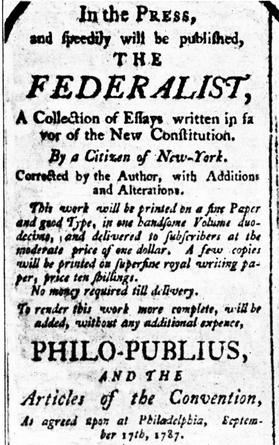
"An Advertisement for the Federalist" | Public Domain
To replace the government that was operating under The Articles of Confederation, the Constitution was proposed, created, and sent to the states for ratification on September 17, 1787. To become law, the new Constitution had to be ratified (meaning approved) by 9 of 13 states (as required by Article VII).
State legislatures were directed to call ratification conventions to debate and then approve or reject the new framework for the national government. Despite unhappiness over the Articles of Confederation, there was significant opposition to the new Constitution and its approval was very much in doubt in many states.
The debate over the ratification of the U.S. Constitution is known for the sharp divide it created among people in the newly independent states.
Two groups, the Federalists and the Anti-Federalists, emerged with the Federalists arguing for ratification and the Anti-Federalists arguing against the ratification. Federalist supporters of the Constitution included James Madison, Alexander Hamilton, and John Jay, the authors of the Federalist Papers. Anti-Federalist opponents included George Clinton, Patrick Henry, and James Monroe (the future 5th President).
The new Constitution was finally approved on June 21, 1788 when New Hampshire became the 9th state to ratify (The Day the Constitution Was Ratified).
What were the main disagreements between Federalists and Anti-Federalists? The modules for this topic outline the two sides, the role of women in the debates, and how those disagreements are still impacting our lives and our politics today.
Modules for this Standard Include:
- INVESTIGATE: The Federalist-Anti-Federalist Debates
- MEDIA LITERACY CONNECTIONS: Political Debates Through Songs from Hamilton: An American Musical
- UNCOVER: Abigail Adams, Mercy Otis Warren, and the Political Roles of Women
- ENGAGE: Who Should Have Primary Responsibility for Environmental Policies?
1.INVESTIGATE: The Federalist-Anti-Federalist Debates
The Federalists believed that the Constitution would create a needed change in the structure of government. In their view, the Articles had created disarray through a system where state governments competed with one another for power and control. Federalists hoped the Constitution would establish a strong central government that could enforce laws of states, get things done, and maintain the union. It would create stability and the promise of growth as a unified nation. Key examples of the views of Federalists can be found in Federalist Paper Number 10 and Federalist Papers Numbers 1, 9, 39, 51, and 78.
The Anti-Federalists feared the Constitution would create a central government that would act like a monarchy with little protection for civil liberties. Anti-Federalists favored power for state governments where public debate and citizen awareness had opportunities to influence and direct state and national policies. Important primary sources for Anti-Federalists include The Federal Farmer I, Brutus I, and the Speech of Patrick Henry (June 5, 1788).
The divide was intense and in most states, ratification of the new Constitution just barely happened. The Massachusetts vote, held on February 6, 1788, was 187 for ratification; 168 against.
You can learn more at our wiki page, Federalists and Anti-Federalists.
Suggested Learning Activities
- Argue a Federalist and an Anti-Federalist Position
- Minimum Wage Laws
- Early Voting Days and Times
- Motorcycle Helmet Laws and Traffic Speed Limits
- Environmental Protections and Air Quality
- Should States or the Federal Government Have Primary Authority to Make Decisions about the Following Policies:
Online Resources on Federalists and Anti-Federalists
- Multimedia video and lesson plan on the Constitutional Convention from Khan Academy
- The Question of States' Rights: The Constitution and American Federalism, Exploring Constitutional Conflicts
2.UNCOVER: Abigail Adams, Mercy Otis Warren, and the Political Roles of Women
While men did the writing of the Constitution, the voices of women were heard in the debates over ratification and the rights of citizens.
Abigail Adams was an advocate for women's rights, supporter of education for women, and active opponent of slavery. She was also the wife of future President John Adams and mother of President John Quincy Adams. Her "Remember the Ladies" letter to husband John Adams is a famous document from the time.
You can read more of her writing at About the Correspondence Between John & Abigail Adams, from the Massachusetts Historical Society.
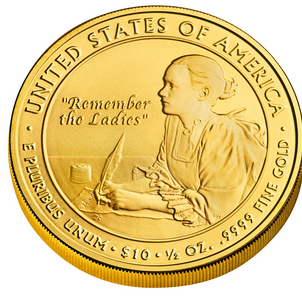
"Abigail Adams 'Remember the Ladies' Coin" | Public Domain
Mercy Otis Warren, from Barnstable and Plymouth Massachusetts, was a poet, playwright, and essayist whose writing was strongly political - a dramatic departure from how women were supposed to behave at the time.
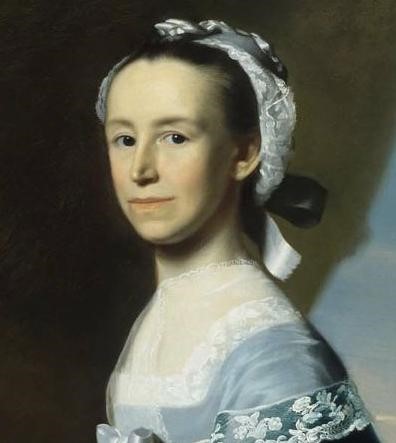
"Portrait of Mercy Otis Warren"
by John Singleton Copley | Public Domain
Mercy Otis Warren has been described as "the leading female intellectual of the Revolution and early republic" (Michals, 2015, para. 1; National Women's History Museum). Warren was both an outspoken supporter of the American Revolution and a strong Anti-Federalist opponent of the Constitution. Like other anti-federalists, her opposition to the new government ranged from the "lack of a bill of rights guaranteeing freedom of the press and the rights of individuals, to the indirect, antidemocratic method for electing the president" (Brown & Tager, 2000, p. 108).
Mercy Otis Warren wrote many political pieces under the pseudonym 'A Columbian Patriot' in support of the Anti-Federalist ideals. Explore her writing at: "Observations on the new Constitution, and on the foederal and state conventions. By a Columbian patriot. ; Sic transit gloria Americana."
Suggested Learning Activities
- Analyze a Video
- Watch the video: The Founding Mothers of the United States: An Overview in which journalist Cokie Roberts and author Walter Isaacson discuss the life and times of Martha Washington, Deborah Franklin, and Mercy Otis Warren.
- What roles did these women play in the beginning of the United States?
- Construct a Timeline
- Using Milestones for Women in Politics website as a starting point, build a timeline of women's political roles in the United States (using Timeline JS, Tiki Toki, or another interactive timeline builder).
Online Resources for the Political Roles of Women in the Early United States
- About Mercy Otis
- Mercy Otis Warren, New World Encyclopedia
- Mercy Otis Marries James Warren, November 14, 1754
- 5 Ways Women Influenced Politics Before They Got the Vote, National Museum of American History
- Persuading male voters
- Crusades against slavery and alcohol
- Compelling narratives
- Political organizing
- Transforming everyday objects into political vehicles
- Did the American Revolution Change the Role of Women in Society? History in Dispute (Vol. 12)
- Founding Mothers: Women's Roles in American Independence.
3. Engage: Who Should Have Primary Responsibility for Environmental Policies?
In fulfilling a 2016 campaign pledge to create more business- and industry-friendly policies (especially for fossil-fuel and nuclear-power companies), the Presidential Administration of Donald Trump has dramatically altered the environmental policies of the federal government.
The Department of the Interior and other federal branch agencies have loosened or eliminated rules and regulations put in place by previous Presidents, rolling back offshore drilling safety regulations, greenlighting oil and gas pipeline projects, granting energy companies access to wildlife habitats, permitting increased logging of federal forests, and easing restrictions on greenhouse gas emissions from coal power plants, among other changes (A Running List of How President Trump is Changing Environmental Policy, National Geographic, 2017; updated 2019; Trump v. Earth, National Resources Defense Council, 2020).
Deregulation policies included replacing the Clean Power Plan, revising and weakening the Endangered Species Act, Coal Ash Rule, the Mercury and Air Toxic Standards, and reversing bans on the use of pesticides in farming (The Trump Administration's Major Environmental Deregulations, Brookings, December 15, 2020). You can follow changes in environmental rules and policies with a Climate Deregulation Tracker from the Sabin Center for Climate Change at Columbia University School of Law.
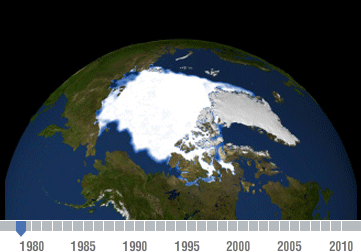
"Declining Arctic Sea Ice, 1979-2010"
Public Domain
The Trump Administration's environmental policies have placed the federal government in direct and contentious opposition to numerous state governments, notably those controlled by Democrats. That state governments have a central role in environmental policy has been established in court, namely Massachusetts v. EPA (2006), a landmark climate change case where the Supreme Court ruled that a state government had the authority under the Clean Air Act to regulate auto emissions. That decision was written by Justice John Paul Stevens who wrote a number of significant environmental decisions during his time on the Court; Stevens died in 2019 at the age of 99.
Trump policies led to direct conflicts with states, notably California which has enacted stricter environmental protection laws than most of the rest of the states in the country (California sues Trump again for revoking state's authority to limit auto emissions). It is one of the latest examples of the historic tension in American politics between states' rights and federal power—a tension that goes all the way back to the Articles of Confederation and what policies are to be controlled states or by the national government.
The Yosemite Land Grant of 1864, signed by President Abraham Lincoln on June 30 of that year, was the first time the federal government set aside land specifically for preservation and recreational use. This area became Yosemite National Park in 1890.
The federal government established the world's first national park, Yellowstone National Park in 1872. However, it did so on lands that native tribes consider sacred, adding another source of dispute between American Indians and the U.S. government (Yellowstone National Park Created on Sacred Land).
The National Park Service was created in 1916. Following the publication of Rachel Carson's seminal book Silent Spring (1962), Congress passed the Clean Air Acts of 1963, 1970 and 1990 along with the Clean Water Act in 1972. There is more historical background and information at a resourcesforhistoryteachers wiki page, The Clean Air Act.
Following the first Earth Day (1970), the Environmental Protection Agency (EPA) was established in 1970. As President, Barack Obama took numerous steps to extend environmental protections (Mother Nature Network, 2016).
Following the election of Joe Biden in 2020, Republican led states (asserting their powers as state governments under federalism) began passing legislation making it harder to reduce dependence on fossil fuels (coal, oil, and natural gas). The state of Florida, for example, passed a bill to prevent the city of Miami from banning natural gas infrastructure in new buildings.
The Biden Administration has responded by pausing new oil and gas leasing on public lands and water and reversing other Trump-era environmental and energy policies. You can track Joe Biden's environmental actions as President at this site from The Washington Post.
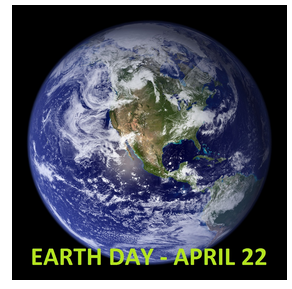
Earth From Space, 2010
"Earth Day - Earth from Space" by TheOriginalSoni is licensed under CC BY-SA 3.0
Suggested Learning Activities
- Design a Sustainability Ambassador Role for You and/or Others
- Propose this role for yourself, another student, or group of students as a school, classroom, or family sustainability ambassador.
- What steps could that person(s) take to improve air and water quality, food safety, waste reduction, and other environmental and climate justice concerns.
- Design a poster or short video explaining the role and its goals.
- Write a Public Policy Brief
- What are the limits of states' rights and federal power in matters related to the environment?
- Can states block federal directives?
- Can the federal government ignore state laws?
- Should state governments or the federal government have primary responsibility for modern-day environmental policy?
- Learn Online: Preventing Natural Disasters
- Play Stop Disasters, a group of digital games from the United Nations Office for Disaster Risk Reduction where players must try to avert natural disasters - tsunamis, wildfires, hurricanes, earthquakes and floods - from happening.
- How successful were you in preventing a disaster?
- What did you learn about environmental policy choices from playing one of these games?
- Play Stop Disasters, a group of digital games from the United Nations Office for Disaster Risk Reduction where players must try to avert natural disasters - tsunamis, wildfires, hurricanes, earthquakes and floods - from happening.
Online Resources for States Rights vs. Federal Power in Modern-Day Environmental Politics
- Toxic 100 Names Top Climate, Air and Water Polluters, Political Economy Institute, University of Massachusetts Amherst, July 29, 2019
- How the U.S. Protects the Environment, from Nixon to Trump, The Atlantic (March 29, 2017)
- In Trump Era, Democrats and Republicans Switch Sides on States' Rights, Reuters (January 26, 2017)
- The States Resist Trump's Environmental Agenda, Earth Institute, Columbia University (May 7, 2018)
- Environmental Laws Timeline Activity, American Bar Association
- Take a Poll, Debate the Issue: Environmental Policy, PBS Newshour (May 31, 2016)
- Is the "Right to Clean Water" Fake News? An Inquiry in Media Literacy and Human Rights, Social Studies and the Young Learner (2020)
Standard 2.4 Conclusion
During the writing of the Constitution, Federalists and Anti-Federalists offered sharply diverging visions for the roles of state and federal government, differences which have continued in American politics to the present day. I NVESTIGATE outlined the main points of the Federalist-Anti-Federalist debates. UNCOVER examined the political roles of women through the actions of Abigail Adams and Mercy Otis Warren. ENGAGE placed the debates between Federalists and Anti-Federalists in a modern-day context by asking what level of government should have primary responsibility for environmental policies?
Source: https://edtechbooks.org/democracy/debates